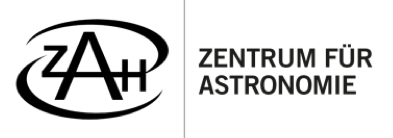The search for Earth-like planets has made significant progress: A new study by the CARMENES project led by Heidelberg astronomers shows that very low-mass stars with less than a sixth of the mass of our Sun are particularly likely to host Earth-like planets. On average, there are about two per star. This could very significantly increase the chances of finding potentially life-friendly worlds in our cosmic neighborhood. The results have now been published in the scientific journal Astronomy & Astrophysics.
What is CARMENES?
CARMENES is a high-resolution spectrograph system installed at the Calar Alto Observatory in Spain. It was developed and built under the lead of the Königstuhl Observatory (German: Landessternwarte Königstuhl) to discover exoplanets around so-called M-dwarfs. M-dwarfs are the most abundant stars in our galaxy and have a mass ranging from less than a tenth to about half the mass of our Sun. By observing tiny periodic motions of these stars, caused by the gravitational pull of orbiting planets, researchers can infer the presence of new worlds.
New insights into planetary occurrences
In the current study, the scientists specifically selected 15 stars from a catalog of 2200 M-dwarfs of the CARMENES program and analyzed their radial velocity data. They discovered four new planets around three stars: G 268-110 b, G 261-6 b, and G 192-15 b and c. The three "b" planets have masses between 1.03 and 1.52 Earth masses and orbital periods of 1.43 to 5.45 days. G 192-15 c, on the other hand, is a larger planet with about 14.3 Earth masses and an orbital period of about 3.3 years. Dr. Adrian Kaminski from the Königstuhl Oberservatory, which is part of the Center for Astronomy at Heidelberg University (ZAH), is the head of the study and enthusiastic about the results: "It is really absolutely remarkable how often small planets occur around very low-mass stars." Kaminski and his colleagues were able to show through a sophisticated statistical analysis that stars with less than 0.16 solar masses have about two planets with less than three Earth masses on average. Larger planets, on the other hand, are rarer. This suggests that smaller stars prefer to form smaller planets in close orbits.
Implications for the search for life
We currently know about 5000 planets in other solar systems. None of them, however, is a true "twin" of Earth in terms of its mass, radius, surface temperature, and the type of its parent star. However, the newly discovered planets meet at least the first three criteria. Prof. Andreas Quirrenbach, Director of the State Observatory and expert in the search for exoplanets, considers the new results promising for the search for life outside our solar system. "Small, rocky planets in the so-called habitable zone – the area around a star where water could exist in liquid form – are potential candidates for habitable worlds. Since M-dwarfs are very common and radiate their energy constantly into space over billions of years, they could provide stable environments for the development of life," the astronomer sums up.
However, there are also potential problems. For example, M-dwarfs are often very active stars and can, for example, influence the atmospheres of surrounding planets through "solar storms", much more strongly than is the case with our Sun. This could have serious consequences, because the atmosphere may "evaporate" very quickly. Whether this is the case is currently being investigated by observations with the James Webb and Hubble Space Telescope. Overall, however, the new findings provide valuable clues as to where the search for habitable planets or the search for life itself could be most promising.
Conclusions
The new CARMENES study provides crucial data on the abundance of Earth-like planets around low-mass stars. The discovery that such planets are particularly common in late M-dwarfs opens up new perspectives for astrobiology and the search for extraterrestrial life. Future missions could focus more on these stars to further unlock the mysteries of the universe.
ORIGINAL PUBLICATION
The CARMENES search for exoplanets around M dwarfs. Occurrence rates of Earth-like planets around very low-mass stars
https://www.aanda.org/articles/aa/full_html/2025/04/aa53381-24/aa53381-24.html
ADDITIONAL INFORMATION
Press release of Heidelberg University
Homepage of the CARMENES consortium
Landessternwarte Königstuhl celebrates success of the CARMENES project
CARMENES succeeds in detecting habitable exoplanet
CARMENES helped in finding exoplanet proxy atmosphere
CARMENES contributes to confirmation of earth-size planet
SCIENTIFIC CONTACT
Dr. Adrian Kaminski
Center for Astronomy of Heidelberg University (ZAH)
Landessternwarte Königstuhl
akaminsk@lsw.uni-heidelberg.de
CONTACT FOR THE MEDIA
Dr. Guido Thimm
Center for Astronomy of Heidelberg University (ZAH)
thimm@uni-heidelberg.de
